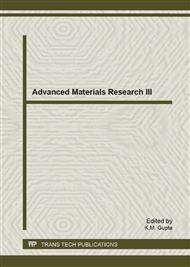p.112
p.119
p.123
p.128
p.134
p.139
p.145
p.150
p.155
Ammonia Gas Sensors Based on In Situ and Drop-Coated Polyaniline Nanostructures
Abstract:
Polyaniline (PANI) nanostructures are successfully prepared and deposited by in-situ and drop-coating on glass substrates without using any template. By changing synthesis and deposition method, a new morphology of nanostructures, “the cauliflower-like structure”, is developed. These nanostructures were then tested as optical ammonia gas sensors by measuring the optical absorbance variations at 632 nm at different NH3 concentrations. The results show a strong dependence of the morphology on the deposition method. The in-situ one leads to better performances compared to the drop coated one. Protonation /deprotonation is the mechanism of interaction between NH3 molecules and PANI nanostructures.
Info:
Periodical:
Pages:
134-138
Citation:
Online since:
April 2013
Authors:
Keywords:
Price:
Сopyright:
© 2013 Trans Tech Publications Ltd. All Rights Reserved
Share:
Citation:


